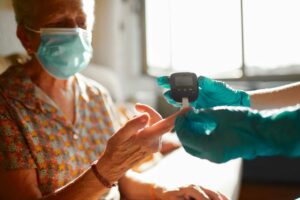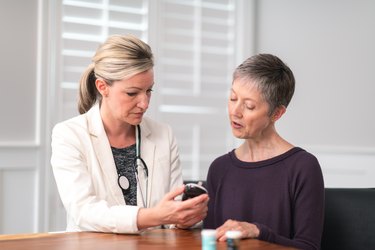In the delicate dance of managing diabetes, the threat of hypoglycemia looms like a shadow, capable of casting individuals into a dangerous state of unconsciousness known as a hypoglycemic coma. This critical condition arises when blood sugar levels plummet to dangerously low levels, impacting the brain’s function. As we delve into the complexities of hypoglycemic comas, this blog aims to shed light on crucial information about effective hypoglycemic coma treatment strategies.
Contents
What Is Hypoglycemic Coma?
 A hypoglycemic coma is a severe and potentially life-threatening complication that arises from extremely low blood sugar levels. It is a condition known as hypoglycemia. In individuals with diabetes, this occurs when there is an imbalance between insulin. This further lowers blood sugar and the amount of glucose in the bloodstream. When blood sugar levels drop too low, the brain is deprived of its primary energy source, leading to a range of neurological and physiological dysfunctions. These disruptions can progress rapidly, causing unconsciousness and, in severe cases, culminating in a hypoglycemic coma.
A hypoglycemic coma is a severe and potentially life-threatening complication that arises from extremely low blood sugar levels. It is a condition known as hypoglycemia. In individuals with diabetes, this occurs when there is an imbalance between insulin. This further lowers blood sugar and the amount of glucose in the bloodstream. When blood sugar levels drop too low, the brain is deprived of its primary energy source, leading to a range of neurological and physiological dysfunctions. These disruptions can progress rapidly, causing unconsciousness and, in severe cases, culminating in a hypoglycemic coma.
It is a critical medical emergency that demands swift and appropriate intervention to restore blood sugar levels and prevent long-term complications or fatalities. The symptoms of a hypoglycemic coma vary but often include confusion, disorientation, seizures, and loss of consciousness. Prompt recognition of these signs and immediate administration is essential to reverse the hypoglycemic state.
What Are The Best Hypoglycemic Coma Treatment Options?
Hypoglycemic coma treatment is a time-sensitive and critical process aimed at rapidly raising blood sugar levels to restore normal brain function. Here are some of the best hypoglycemic coma treatment options:
Oral Glucose or Sugary Foods
When faced with mild to moderate hypoglycemia, the immediate administration of oral glucose or sugary foods serves as a quick and effective way to raise blood sugar levels. Glucose tablets, fruit juice, or any source of rapidly absorbable carbohydrates can be consumed. This method is especially beneficial when the individual is conscious and able to swallow. Individuals with diabetes and their caregivers must carry easily accessible sources of glucose to address hypoglycemic episodes promptly.
Intravenous (IV) Glucose
In cases of severe hypoglycemia where the person is unconscious or unable to ingest glucose orally, intravenous administration of glucose becomes a critical intervention. Emergency medical professionals typically administer a solution containing dextrose directly into the bloodstream. Further ensuring a rapid and efficient increase in blood sugar levels. This method is reserved for situations where oral intake is not feasible, emphasizing the importance of seeking immediate medical attention for severe hypoglycemic episodes.
Glucagon Injection
The administration of a glucagon injection is a valuable treatment option when dealing with unconsciousness due to severe hypoglycemia. Glucagon stimulates the liver to release stored glucose, providing a swift increase in blood sugar levels. Family members, friends, or caregivers of individuals with diabetes should be trained on how to properly administer a glucagon injection. It will help to ensure a timely response to emergencies when the affected person is unable to consume oral glucose.
Continuous Glucose Monitoring (CGM) Systems
For individuals prone to frequent hypoglycemic episodes, continuous glucose monitoring (CGM) systems offer real-time tracking of blood sugar levels. These devices use sensors placed under the skin to provide ongoing data and can alert the user or their caregivers to impending low blood sugar levels. By enabling proactive interventions, such as consuming glucose-rich foods or adjusting insulin doses, CGM systems contribute to the prevention of hypoglycemic comas.
Medication Adjustments
 Regular review and adjustment of diabetes medications, particularly insulin doses, play a crucial role in preventing recurrent hypoglycemia. Healthcare professionals work closely with individuals with diabetes to tailor medication regimens based on factors such as diet, physical activity, and overall health. A personalized approach ensures that medications are effectively managing blood sugar levels without posing an undue risk of hypoglycemia, thereby reducing the likelihood of experiencing a hypoglycemic coma.
Regular review and adjustment of diabetes medications, particularly insulin doses, play a crucial role in preventing recurrent hypoglycemia. Healthcare professionals work closely with individuals with diabetes to tailor medication regimens based on factors such as diet, physical activity, and overall health. A personalized approach ensures that medications are effectively managing blood sugar levels without posing an undue risk of hypoglycemia, thereby reducing the likelihood of experiencing a hypoglycemic coma.
It’s important to note that seeking immediate medical attention is crucial when dealing with a hypoglycemic coma. These treatment options should be administered under the guidance of healthcare professionals, and individuals with diabetes should work closely with their healthcare team to develop a personalized plan for managing and preventing hypoglycemia.
What Helps Hypoglycemia Immediately?
Addressing hypoglycemia immediately is crucial to prevent it from progressing into a more severe state. Here are several steps you can take to raise blood sugar levels quickly:
- Consume Fast-Acting Carbohydrates
The fastest way to raise blood sugar levels is to consume fast-acting carbohydrates. Examples include glucose tablets, sugar cubes, or a small glass of fruit juice. These sources contain simple sugars that the body can quickly convert into glucose for immediate energy.
- Glucose Gel or Liquid
Glucose gel or liquid is another rapid option. These products are designed specifically to raise blood sugar levels quickly and can be administered orally. They are convenient to carry and use in situations where immediate action is necessary.
- Hard Candy or Honey
Hard candies, such as regular (not sugar-free) candies, or a small amount of honey, can be effective in providing a quick source of sugar. Allow the candy to dissolve in your mouth or take a spoonful of honey to help raise blood sugar levels.
- Soda or Regular Soft Drinks
Regular soda or soft drinks containing sugar can also help elevate blood sugar rapidly. However, it’s essential to choose regular versions rather than diet or sugar-free options. Because these may not contain enough sugar for a quick response.
- Fruit
Consuming a piece of fruit, especially one that is high in natural sugars like a banana or a few grapes, can provide a quick source of carbohydrates. However, be cautious with fruits that are high in fiber, as they may not raise blood sugar levels as rapidly.
Remember to follow up the immediate treatment with a more sustained source of carbohydrates, such as a balanced meal or snack, to prevent a recurrence of hypoglycemia. It’s also crucial to regularly monitor blood sugar levels and work with healthcare professionals to adjust medication and lifestyle factors to minimize the risk of future episodes. If symptoms persist or if the person is unconscious, seek immediate medical attention.
How Can I Prevent Hypoglycemic Coma?
 Preventing hypoglycemic comas involves a combination of proactive measures aimed at maintaining stable blood sugar levels. Consider the following strategies for preventing hypoglycemic comas:
Preventing hypoglycemic comas involves a combination of proactive measures aimed at maintaining stable blood sugar levels. Consider the following strategies for preventing hypoglycemic comas:
Regular Blood Sugar Monitoring
Frequent monitoring of blood sugar levels is essential for individuals with diabetes. Regular checks help identify trends and patterns, allowing for timely adjustments to medication, diet, and lifestyle to maintain stable glucose levels.
Consistent Meal Timing and Composition
Establishing a regular eating schedule with well-balanced meals and snacks helps regulate blood sugar levels. Consistency in meal timing and composition can prevent drastic fluctuations in glucose levels and reduce the risk of hypoglycemia.
Carbohydrate Counting
Learn to accurately count carbohydrates in meals and snacks. This knowledge allows for precise insulin dosing, reducing the likelihood of overshooting and causing hypoglycemia. Working with a registered dietitian can be valuable in developing a customized carbohydrate management plan.
Individualized Medication Management
Work closely with healthcare professionals to tailor medication regimens, especially insulin doses, to your specific needs. Adjustments may be necessary based on factors such as physical activity, changes in diet, and overall health. Regular communication with your healthcare team is crucial for optimizing medication management.
Emergency Preparedness
Always carry a source of fast-acting carbohydrates, such as glucose tablets or a small bottle of sugary liquid, to address hypoglycemic episodes promptly. Ensure that family members, friends, or caregivers are aware of the emergency procedures and know how to administer glucagon if needed.
Physical Activity Planning
Plan and adjust physical activity in coordination with your meal and medication schedule. Regular exercise is beneficial for overall health, but it’s important to account for its impact on blood sugar levels. Monitor glucose levels before, during, and after exercise, and adjust food and insulin accordingly.
Continuous Glucose Monitoring (CGM)
Consider using continuous glucose monitoring systems for real-time tracking of blood sugar levels. CGM systems provide valuable insights into trends and can help prevent hypoglycemic episodes by allowing for timely interventions.
Regular Medical Check-ups
Schedule regular check-ups with healthcare professionals to assess overall diabetes management, address any concerns, and make necessary adjustments to treatment plans. These appointments provide an opportunity to discuss lifestyle changes and receive guidance on diabetes management.
By incorporating these preventive measures into your daily routine and maintaining open communication with your healthcare team, you can significantly reduce the risk of hypoglycemic comas and promote overall well-being in the management of diabetes.
Conclusion
In conclusion, understanding and addressing hypoglycemic coma treatment is crucial for individuals managing diabetes. By recognizing the signs, implementing immediate treatment options like consuming fast-acting carbohydrates or administering glucagon, and adopting proactive prevention strategies such as regular blood sugar monitoring and consistent meal planning, individuals can empower themselves to navigate the challenges of hypoglycemia.
Through knowledge, preparedness, and a collaborative effort between individuals and their healthcare teams, the journey of diabetes management can be more secure, allowing for a safer and healthier life. Do you want to get rid of diabetes? Join our online diabetes treatment program and reverse Diabetes naturally through lifestyle changes such as a Personalized Diet plan, Exercise, Yoga, dieticians, and health coaches.

